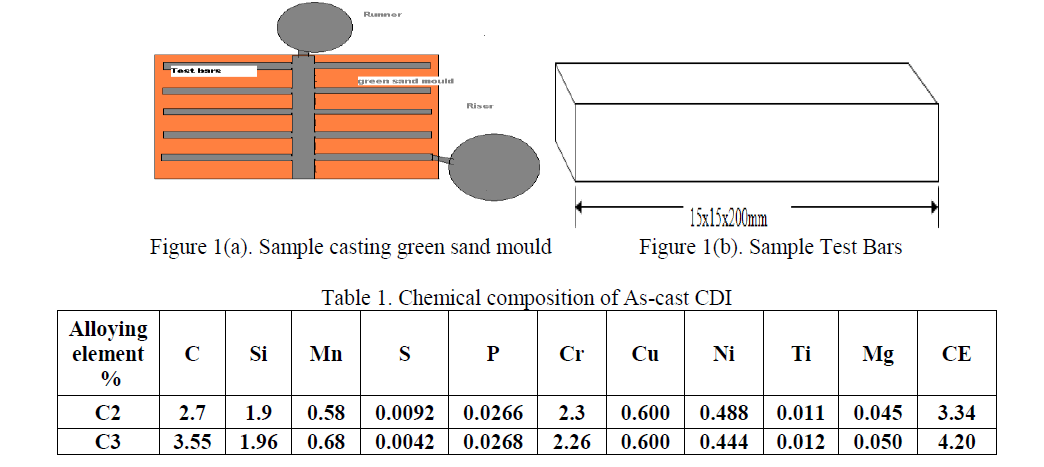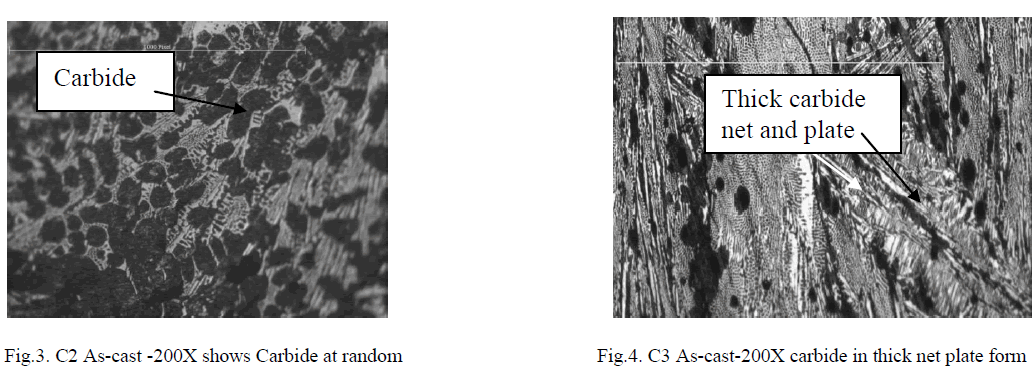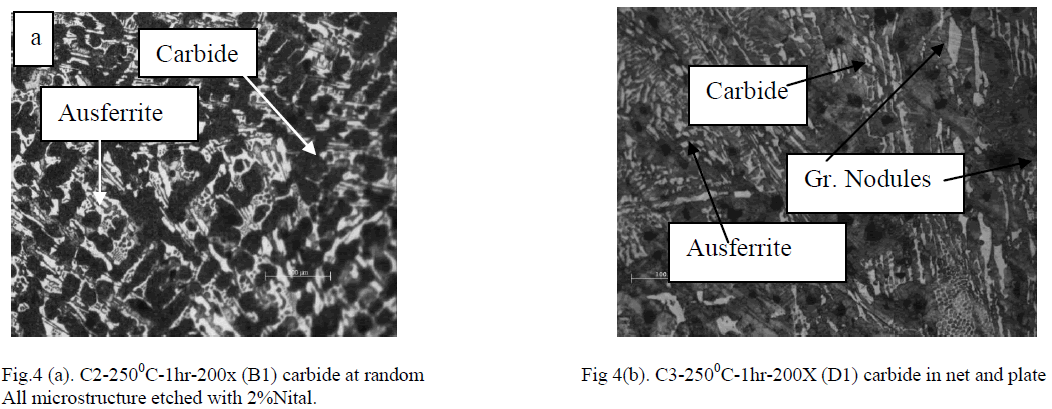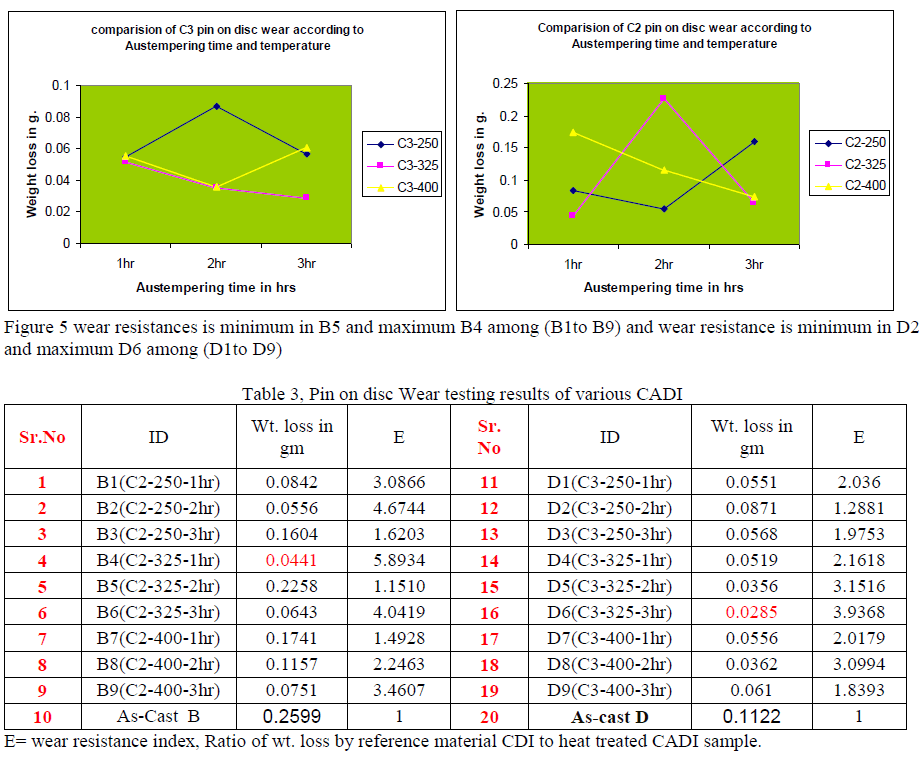ISSN ONLINE(2319-8753)PRINT(2347-6710)
ISSN ONLINE(2319-8753)PRINT(2347-6710)
S A Patil1, S U Pathak 2 ,Ajay Likhite2
|
| Related article at Pubmed, Scholar Google |
Visit for more related articles at International Journal of Innovative Research in Science, Engineering and Technology
The abrasion wear resistance of iron is improved by the incorporation of an extra phase in the matrix, typically consist of carbides. The objective of the present work is to produce carbides in a ductile cast iron which is subsequently austempered, to obtain the carbidic austempered ductile iron (CADI). Two variants of (CADI)were produced by heating carbidic ductile iron (CDI) to a austenitization temperature of 9000C for the period of 1hr and quenching in salt bath at temperature range 2500C,3250Cand 4000C for the period of 1hr, 2hr, 3hr respectively. The microstructural characteristics of the produced CADI were evaluated by optical microscope. The abrasion wear resistance was evaluated by testing in accordance with ASTM G 99 standard. Carbidic ductile iron (CDI) as-cast samples were taken as reference material to determine the relative wear resistance index E. The results obtained, allow to establishing a relationship between Cr content in the alloy, austempering parameters, microstructure and mechanical properties of CADI. It was found that increase in the CE, content in CADI increases the volume fraction of Carbides in an alloy which resulted in to enhancement in hardness and wear resistance.
Keywords |
| Carbidic austempered ductile iron; Austempering; Microstructure; Carbides; Abrasion. |
INTRODUCTION |
| Austempered Ductile Iron (ADI) has been long recognized for its high tensile strength (over 1600MPa for grades 5 and 1, according to the ASTM A-834-95), replaced forged steels in many applications. It is also well known ability of this material to perform very well under different wear mechanisms such as rolling contact fatigue, adhesion and abrasion[1],[2],[3] . ADI has proved to behave in a different manner under abrasive conditions, depending on the tribosystem (lower high stress abrasion), but always possible to obtain a good performance in wear if the heat treatment parameters are selected properly. A new type of DI, containing carbides immersed in the typical matrix of DI, called Carbidic DI or CDI has been developed. A new type of CDI, containing carbides immersed in the typical ausferritic matrix, called carbidic ADI or CADI has been recently introduced in the market. The available literature of CADI shows only application examples and data about the response to abrasive wear but not the procedure to produce CADI. CADI is a ductile cast iron containing carbides, (that are induced either thermally or mechanically), that is subsequently austempered to produce an ausferritic matrix with an engineered amount of carbides. Methods of carbide introduction include: As-Cast Carbides: Internal (chemical or inverse) chill: Surface chill (limited depth, directional). Mechanically Introduced Carbides: Cast-in, crushed MxCy carbides; Cast-in, engineered carbides (shapes).Welded: Hard face Weldment; Weldment with MxCy grains.[4],[5]. The presence of carbides promotes an increase in the abrasion wear resistance. The development of this material is possible; if heat treatment parameters, microstructure is controlled properly in order to obtain the maximum abrasion resistance. One of the methodologies commonly used to obtain a microstructure with as-cast carbides is to reduce the quantity of graphitizing elements (in particular Si), in order to promote the precipitation of ledeburitic carbides during solidification due to a closer interval between the stable and metastable diagrams[14]. A second option is to alloy the melt with carbide stabilizing elements, such as chromium, molybdenum or titanium [4],[5], which strongly reduce the interval between stable and metastable eutectic temperatures and promote total or partial solidification according to the metastable diagram[6]. It must be taken into account that an under cooling also affects the size and count of the solidification units, and therefore, the microsegregation. The lower the cooling rate, the greater the microsegregation effect increasing the probability for carbide precipitation at the last to freeze zones[14], therefore, the formation of alloyed carbides. Then, the size and composition of carbides may vary, from typical unalloyed ledeburitic to thin plate shaped high-alloyed carbides, depending on the chemical composition and cooling rate[6],[7],[8],[9].It was demonstrated[10]that ledeburitic carbides produced either by controlling the cooling rate or the silicon level (nonalloyed carbides) have a high tendency to dissolve during the austenitizing stage and are less stable than alloyed carbides. Alloyed carbides are stable no dissolution during heat treatment[16]. The objective of this work is to produce two variants of CADI, studying their microstructural characteristics and evaluating the abrasion resistance. |
II. EXPERIMENTAL PROCEDURE |
| 2.1 Material and Sample Preparation Two different carbidic ductile iron heats (C2 and C3) were produced in a metal casting foundry using a 100 kg capacity 3 kHz induction furnace. Steel scrap and foundry returns were used as charge materials. Two heats were used to produce CDI samples. One of them is hypoeutectic while the other one nearly eutectic. Two were alloyed with Cr to favor the precipitation of alloyed cementite (Fe, Cr) 3C. All the heats were nodulized by sandwich method with Fe–Si– Mg (9 wt% Mg) alloy, at the pouring temperature of 15000C, and inoculated with Fe–Si (75 wt% Si) in preheated ladle. The small additions of copper and nickel were made so as to provide enough austemperability16. The shape and dimensions of the model used to make the moulds for casting are shown in Fig. 1(a), it is of near net shape casting test bars of size 15x15x200mm. CADI samples were obtained from the same two heats alloyed with Cr after a heat treatment involving an austenitizing stage of temperature 900°C in a muffle furnace for Tg-1h, followed by an austempering step in a salt bath at Ta-250°C, 325°C, 400°C during quenching time ta-1h,2h,3h. Thus obtained test bars are sliced in 15mm long to test sample for microstructural characterization and hardness measurement. The wear samples Sliced of about 15x15x50mm long of 8mm diameter cut with EDM wire cut for as-cast, as well as for CADI wear samples preparation, CDI samples used as reference material. |
 |
| The chemical composition of the alloys was measured by means of a spark emission optic spectrometer with a DV6 excitation source. Metallographic sample preparation for optical microscopy examination was conducted by using standard cutting and polishing techniques, and etching with 2% Nital. The volume fraction of carbides was measured by image analyzer. For this purpose, carbides were revealed by etching with 10% ammonium persulfate in aqueous solution. The magnification used to obtain data from a sufficiently large area was X50.Each reported value is the average of four measurements. |
| 2.2 Chemical and Micro structural Examination The chemical composition of the alloys was measured by means of a spark emission optic spectrometer with a DV6 excitation source. Metallographic sample preparation for optical microscopy examination was conducted by using standard cutting and polishing techniques, and etching with 2% Nital. The volume fraction of carbides was measured by image analyzer. For this purpose, carbides were revealed by etching with 10% ammonium persulfate in aqueous solution. The magnification used to obtain data from a sufficiently large area was X50.Each reported value is the average of four measurements. 2.3 Mechanical Tests Rockwell hardness was measured at 150 kg load (HRC) on C-scale. A hardness profile was obtained for each alloy. In order to determine the hardness of the carbides and the matrix separately, micro indentation tests were carried out by using a Vickers indenter at a 200g load (HV200). The abrasion wear resistance was evaluated by performing the âÃâ¬Ãâ¢Pin on disc Abrasion TestâÃâ¬Ãâ the disc is of diamond ring having hardness of around 3000Hv and width of 10mm. According to the ASTM G-99 standard, and using the procedure A (test load 20N, distance travelled for 14450meter, at 400rpm and track radius 58mm). The Relative Wear Resistance index, E, was obtained as the ratio between the weight loss experienced by the Carbidic Ductile Iron (CDI) samples, used as reference material (WLR), and the CADI samples (WLS), according to Eq. (1). The weight loss values were measured by means of a 0.1 mg precision scale. E=WLR / WLS ------ (1) |
III. RESULTS AND DISCUSSION |
| 3.1 Chemical and Microstructural Characterization Table 1 lists the chemical compositions of Carbidic Ductile Irons (C2 and C3). It should be noted that C3 was hypoeutectic (CE=3.34%) and alloyed with 2.3% Cr, C4 (CE=4.20%) nearly eutectic and alloyed with 2.26% Cr. All heats were alloyed with chromium in order to promote partial solidification according to the Fe–C metastable diagram[14]. This, in addition to the microsegregation effect, led to alloyed eutectic carbides formation. Figure 2 and 3 show the microstructures as-cast composition C2, C3 and figure 4a, 4b shows microstructure of austempered samples B9, D9. In C2 the carbides precipitated at grain boundaries. And in C3 the carbides are at random in thick net plate needle form. After austempering CADI samples, the matrix was ausferritic exhibiting the typical morphology, there is no change in the morphology and volume % of carbide. The carbide precipitated as a function of the Cr%, CE and Silicon. It is noticed that the carbide content in samples C3 was higher than that in sample C2, Due to the lower silicon level. The graphitizing potential seems to be a dominant parameter controlling carbide formation. It can be further observed that the carbide content in all samples (B1-B9 and D1-D9) remain same after the heat treatment cycle, No dissolution of alloy carbides was occurs at the austenitizing temperature Tg[15]. |
 |
 |
| 3.2 Mechanical properties 3.2.1 Hardness Tests The Rockwell hardness on C-scale was determined for all samples B1-B9 and D1-D9 bulk hardness was determined as average of five measurements. The results of the three austempering temperatures and three quenching durations in salt bath are determined. The reinforcing effect of carbides increases with the chromium content and the reinforcing effect of carbides on hardness was varies with the three austempering temperatures. The Vickers micro hardness was determined as the average of six measurements in each alloy in a region of carbide and ausferrite. Carbides are randomly precipitated through out the sample. Micro-hardness of Carbide phase is found around 700HV200 to 985HV200 and for other than Carbide phase i e for ausferrite around 350HV200 to550HV200. Figure 8 shows the wear resistance of as cast CDI samples. It is observed as the hardness decreased the wear increased and hardness increased the wear decreased. 3.3.2 Wear resistance The Pin on disc wear test is conducted in accordance with ASTM G-99 standard[11]. Table 3 shows the weight loss values for the CDI As-cast (C2 and C3)and for CADI samples (B1toB9 and D1toD9) measured on pin of 8mm diameter 35mm long and Diamond ring Disc. The least wear resistance is obtained in CDI for C2 and in CADI for B5 (C2-3250C-2hr) and Maximum wear resistance is obtained in CDI for C3 and in CADI for D6 (C3-3250C-3hr). Figure 5 shows the graph of weight loss values obtained for eighteen variants of CADI samples (B1toB9 and D1 toD9) at the three austempering temperatures, (2500C, 3250C and 4000C) and three quenching times 1hr, 2hr and 3hr. The reported values are the average of four determinations, in each case, the CADI samples were compared against the CDI samples and wear resistance index E is determined and shown in Table 3. Weight loss is the functions of the chromium content, carbon equivalent, austempering heat treatment parameters and microstructure matrix. In case of B1-B9 the Cr% is 2.3% it has been shown more wear resistant for B4 (C2-3250C-1hr). In case of D1-D9 the Cr% is 2.26% it has shown more wear resistant for D6 (C3-3250C-3hr). Austempering at 3250C the reinforcement effect of carbide and ausferrite is matched to the hardness values which are higher, reported in the graph of figure 5 and accordingly the wear resistance is more, which is indicated in Table 3. |
 |
 |
| In the category of C2, the Micro-hardness Hv values of carbide phase for C2-325-1hr is around 752 Hv, dominating in the category of C2 various time and temperature. The Micro-hardness Hv values of other than Carbide or Ausferrite phase is less for C2-325-1hr around 450 Hv ,The wear resistance or weight loss during pin on disc wear test is least for C2-325-1hr it is around 0.0441g for 15000m in the category of C2 various time and temperature. In the category of C3, the Micro-hardness Hv values of carbide phase for C3-325-3hr is 985.55Hv dominating in C3 Category. The wear resistance or weight loss during pin on disc wear test is least for C3-325-3hr it is around 0.0285g for 15000m in the category of C3 various time and temperature. In the CADI category of C2, Cr percent of 2.3 and C3, Cr percent 2.26 the C3 is dominating in the wear resistance properties compared to C2, Thus it seems as Cr percent various from 2.3 to 2.26 the wear resistance properties enhanced, there is no much variation in Cr% but considerable variation in CE, i.e. 3.34 to 4.20 .The CE and the effect of Austempering in the C3-3250C-3hr is dominating to enhance the wear resistance properties of C3and accordingly yielding the hardness of carbide phase and Ausferrite phase. Thus from the above result discussion it is found and may be advisable that in the category of C2, 3250C-1hr is desirable and in the category of C3, 3250C-3hr is desirable and compared to both, C3-3250C-3hr is more desirable in enhancement of wear properties. |
IV. APPLICATIONS OF CADI IN REAL PARTS |
| The application of CADI under ideal conditions, Material handling equipments, like conveyor, chute, In power plant Ash handling equipment, cattle feed extruder, cam shaft of IC Engine, Earth mover component, soil aerator, centrifugal pump component, cylinder liner, agricultural and mining machinery[13], Equipment bucket loader, pipes the use of a material for a new application should be evaluated through field tests, even with their associated difficulties such as higher cost, sample tracking, machine shut downs, etc. The performance of wheel loader bucket protection plates made of CADI containing 1.0 and 2.0% Cr and austempered at 3000C is currently being assessed by field tests, using a conventional ADI also austempered at 3000C as reference material. This type of solicitation was deliberately chosen in order to get abrasive conditions different to that evaluated in the lab[13]. |
V. CONCLUSION |
| It is possible to obtain Carbidic ADI (CADI) with different amount of carbides using Cr as the main alloying element. The carbide contents are obtained by alloying with Cr between 2.26 and 3%. All most all carbide was stable during the austenitizing stage of the austempering and the amount of dissolved carbides was nil and negligible. The presence of carbides in the microstructure increase the wear resistance, after austempering the wear resistance was increased up to 580% is observed in B4 compared to CDI as-cast, this is due to reinforced matrix of three phase’s ferrite, ausferrite and carbides. Under the present experimental conditions in the alloys containing 3% Cr precipitates the thick net and plate needles form carbides significant reinforcement of the matrix with respect to abrasion. The highest wear resistance was obtained for sample D6, with the chromium content (2.26% Cr) and CE=4.2 the austempering temperature (3250C-3hr). The CADI alloys containing 2.3% Cr too showed better values of wear resistance compared to CDI. Under CADI variants of 2.3% Cr category samples B4 (C2-3250C-1hr) is more wear resistance. |
References |
|